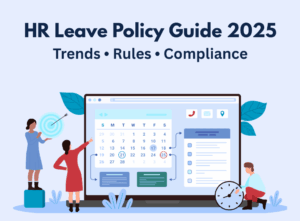While startups are known for their high productivity and flexible work culture, one of the dark sides often overlooked (until too late) is employee attendance. It’s hard to draw the line between flexible work timings and policy abuse, and harder to recognize when one is crossing it.
The proper management of such attendance issues tends to become a highly challenging task. This is because one needs to juggle between creating a time-bound work culture that is diligent and efficient, without making employees feel unappreciated or undervalued.
If you too have been wondering how to curb excessive employee absenteeism, here are 8 surefire steps which can help you devise a consistent, clear and transparent approach:
1. Craft A Policy
To begin with, make sure that your company has a comprehensively structured attendance policy. This policy shouldn’t just contain information about the number of leaves allowed per person, but it should also spell out the consequences of needless absenteeism. Craft a detailed reporting procedure which the employees have to follow in case they intend to skip work and put it in writing. This would ensure that your employees do not take casual absences lightly.
2. Keep Data Handy
Gathering information about the specific dates and times on which employees have been late or absent, would go a long way in helping you address the issue. Have a dialogue with each one of your employees and tell them that their absence has been noticed. A casual conversation with a first-time offender might work. However, when it comes to repeat offenders, their absenteeism would need to be formally recorded. In both cases, keeping data handy would equip you to broach the subject with credence.
3. Discuss With Concern
An open-heart discussion will be a very useful tool for sorting different attendance issues. Provide your employees with a comfortable space, wherein they can hold a candid discussion with you. Begin the conversation by listening to their grievances and offering practical solutions. Tell the employees that while you are not happy with their absences, your first concern is for their well-being. Doing so would enable them to speak with you without any inhibitions.
4. Make suitable accommodations
The appropriate management of human resource requires a thorough understanding of the individual circumstance. For example, some employees might be running late because they have to drop their children off to school, while some others might not show up because of a lack of proper transport arrangements. In each one of these cases, making small accommodations can help rectify absenteeism. Draft a flexible shift schedule that considers employee convenience without hampering your business needs.
5. Identify Stress Triggers
Personal or professional stress can often lead to excessive absenteeism. This is why it is important to identify and ameliorate stress triggers in time. In order to do this, you would need to create a work environment that is open, healthy and interactive. Organize activities which can develop and strengthen an interpersonal relationship between employees and employers. Find ways to hold their interest while keeping them motivated. This would give your employees a chance to unwind and thereby, combat various forms of stress.
6. Give Hourly Leaves
Counting the total numbers of leaves availed, in terms of hours instead of days, has the potential of lending your organization, a better employee perspective. For instance, if an employee has an appointment with a doctor, it wouldn’t make sense for him to request a 24-hour leave. He can simply take off for an hour and report back on time! Therefore, by giving out hourly leaves, you can greatly improve employee entitlements and ensure that their needs remain aligned with the goals of your business.
Also read: 5 tips to retain your best employees
7. Begin Counseling
There might be occasions when none of your interventions would seem to work. Despite the best of your efforts, employee absenteeism would persist. In such a time, it would be wise to refer the errant employees to a formal counselling session. This counselling could either come from an HR representative, or it could be provided by the employee’s immediate superior. Nonetheless, make sure that you lay out all your attendance expectations clearly and ask the counsellor to prevent unexcused absences.
8. Seek Professional Help
Last but not least, seeking professional help would prove to be a good final resort. Consulting advisers who have had years of experience in dealing with employee attendance issues would equip you to handle exigent situations in a delicate manner. More so, these professionals would also be able to suggest business-specific and innovative measures which can ensure compliance, save time and reduce overall employee absenteeism.
If your organization has consistently been bogged down due to employee attendance issues, online platforms like Kredily can come to your rescue. Our automated leave management system allows you to keep track of your employees without making them feel bound by too many rules.

You can set work hours amidst other employee attendance rules. They can punch in and out as they come and go. When your attendance management system records too many anomalies, you can have a conversation with them with all data at your disposal. Isn’t that the easiest solution?
How would you tackle employee absenteeism in your startup? Have you come across any of the above scenarios before? Anything you would have done differently? Would love to hear from you in the comments section below.


